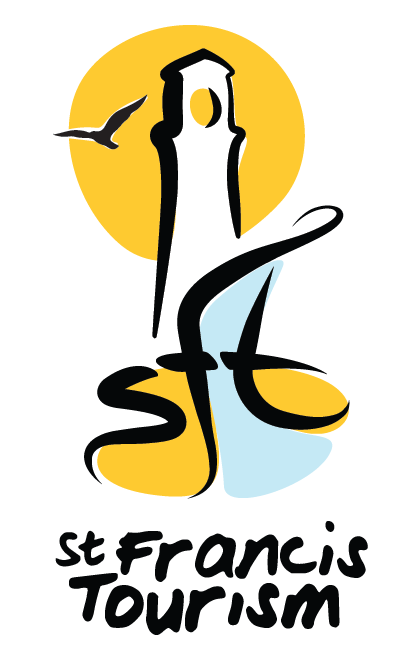Another one of those amazing Bird Island days
Since 1997 Raggy Charters and the Baywatch Marine Conservation Project (established 1992) have amongst other things been assisting marine scientists with research in Algoa Bay. Although the scientists now have their own state of the art catamaran it was on duty at Storms River. After making the necessary arrangements with Dr Matt Dicken we set off in Orca 2 very early on the 24th July 2012. Dr Malcolm Smale, Michelle Du Toit and a chum master were present. We were loaded with plenty of stinky sardines, bits of yellowtail and some old sharks.
After two hours we reached Black Rocks, which are five rocky outcrops on the western side of the group of four islands which make up the Bird Island group. Black Rocks is home to about 3500 Cape fur seals which produce about 700 pups per year. This is the eastern extremity of their range. We anchored Orca 2 about 20 metres off the bricks in about 20 metres of water. The chum master donned his willies and did a jive on a bucket of deceased sardines. These were poured overboard at regular intervals throughout the day. A washing machine drum was filled with more sardines and anchovy oil was thrown into the mix. The feast was rounded off with a large yellowtail bait attached to a buoy and a rather shy looking seal made out of carpet which was also attached to a buoy. Before five minutes was up we had our first diner, a 3,5 metre white shark!
Action from the Crow’s Nest
When photographing marine life in Algoa Bay I always try and get some recognisable feature in the background. Without this the admirer can get the feeling that the photo could have been taken anywhere in the world. So wanting to get the BI lighthouse in the shot I grabbed my camera and clambered up onto the roof of Orca 2. Luckily for me the BBC had been here in April filming the sardine run in 3D for their new program entitled “Earthflight” which is about the migration of birds around the world. They had the crow’s nest built atop the cabin on which they could hang their fancy 3D cameras without fear of losing the lot over the side. From this vantage point you can see much further and in a 360 degree arc. While watching the seals coming and going I asked the shark team if they had ever observed a successful attack on one of them by a white shark. No they echoed, it does not seem like they predate that much on them here as from photos of the seal colony very few seals are observed with shark bite wounds. In the 20 years that I have been going to BI I have also never witnessed a seal predation as is the case with many others I have spoken to. This is in stark contrast to False Bay where over 2600 such attacks were documented between 1997 and 2004.
The Polaris Breach
After taking plenty of photos I packed my camera in its bag at my feet and gazed towards the south hoping to see a blow from a humpback whale on its northern migration. All of a sudden a mere 40 metres away a four metre monster exploded out of the water with a large seal clamped firmly in its jaws. Before it hit the water on its return it had been ripped in two. After wolfing down the one half it turned on the other which it again ripped in two. At this stage I was screaming at the scientists to look but due to their lower position and the high waves they were struggling. They located it just in time to see the last piece of meat disappearing past those menacing jaws. It must be fairly common as the trained kelp gulls were on the scene within seconds to picks up the tasty pieces. I was so astounded that I did not even have time to think about taking a photo. Anyway I would have probably missed the photo as well as the action . . . . , sometimes it is just best to savour the moment than to see it through a pokey lens.
Is your boat insured?
From now on the camera stayed firmly in place around my neck tucked into my fleece. I watched as the gulls moved closer towards us meaning that the departed seal’s blood was heading for us between a gap in the rocks. The next minute our 3,5 metre first arrival launched himself out of the water and attached his jaws firmly to the shaft of my Suzuki 150hp outboard. Dr Malcolm Smale leapt back as the violent slashing of the tail moved in a 180% arc behind the boat. Eventually the beast bit of a section of the plastic which could not have been to his liking. Nonplussed after making a fool of himself he launched into the other outboard. He did not get such a good hold on this one but his teeth marks reach twice as high up the shaft. I leapt down from the roof and trimmed up the outboards determined not to have to spend the night in the BI channel awaiting spares. The port engines propeller had just cleared the water when the beast again shot out of the water and attached its fearsome jaws to the shiny metal. The next to go was the fake seal which was ripped from its buoy and descended beneath the waves. It popped up like a cork a few seconds later only to be ruthlessly savaged on the surface. After we had all calmed down to a panic Dr Matt Dicken turned around and casually asked if my boat was insured! Yes it is I replied but if the insurance company does not believe me I’ll be knocking at your door in the not too distant future with an invoice in my hand.
Why is it so unique?
The team have been at the white sharks in Algoa Bay since 2009. What makes this study so unique is that it is the only area of abundance of white sharks along the coast that does not have a shark cage diving operation associated with it. Although a permit for cage diving was offered for BI no one took it up due to the logistics associated with running an operation 60km from port. If someone does take up the challenge then this study will be the first direct comparison in the altered behaviour, if any, in a white shark population pre and post cage diving and the associated chumming. Some uninformed people who get massive and emotional press coverage argue that this is causing sharks to change their behaviour, resulting in more sharks attacks on humans. Not true say the experts. As long as the sharks were not fed, habituation would probably not occur. In the unlikely event that it did occur, then the association would be with the cage-diving vessels and therefore not an increase in risk to other marine users.
The study so far
Since 2009 surveys around BI have been conducted on a monthly basis. During these three years only about 50 different sharks have been identified confirming that the actual number of sharks present at any one time is relatively few. The arrival of each shark is recorded as well as any identifying notches of the dorsal fin or any other part of the body. Although wind speed and direction, water clarity and sea temperature are measured it is only a high air pressure that seems to attract slightly more sharks. Up to now twelve “acoustic” tags have been attached just below the dorsal fin at BI. Matt uses a spear gun to attach them after the shark has been lured closer to the boat with the help of a mouth-watering piece of yellowtail. A further 39 acoustic tags were inserted internally by the “shark men” team at Mossel, Gans and False bays and a further 8 on smaller white sharks close inshore at Hougham Park by Matt and his team. Matt is able to monitor the movement patterns of these tagged animals using an array of “listening stations”, which have been deployed at various under water locations within the MPA and throughout Algoa Bay. The listening stations detect the presence of any tagged sharks that swim within a radius of approximately 500m.
Algoa Bay, a nursery or breeding ground?
Sharks observed by the team range in size from 1,5 to 4,5 metres with 68% of these being juveniles, that is less than three metres in length. According to statistics worldwide, white sharks are born at between 1,26 and 1,69 metres and at two metres they change their diet and start seeking out mammals. Shore fishermen on Algoa Bay beaches catch more small white sharks (less than 1,6 metres) than anywhere else along the SA coast. This is in contrast to the Western Cape where monsters of up to five metres are not uncommon. The largest on record is a 5,67m giant that was captured off Gansbaai. Despite white sharks being attracted to the 3500 seals on Black Rocks, it does not have the same attraction as the 50 000 seals on Seal Island in False Bay off Cape Town. Smaller sharks would probably avoid these locations in case they ended up as part of the menu themselves. Bird Island would be a much safer bet and hence the majority of sharks observed here are relatively small.
Bad time for a swim at Bird Island
Sharks were only observed at BI in the winter months between April and November. The peak was in mid-July. On our fateful day we had seven different sharks swimming around the boat. Matt informed me that in June this year they had seen ten sharks and attached six tags. In June we had seen seven of which three were tagged and we deployed another tag. In August six were sighted three of which had tags. It seems highly likely then that there are not all that many sharks at BI, probably not more than 50 different sharks in the past three years.
Their peak at this time of the year coincides with the period when seal pups are starting to venture into the water for the first time after weaning. The greater number of inexperienced seals in the water means a greater chance of a successful strike by a white shark. Small pups are usually swallowed whole while juveniles are split in half like the one we observed, as if hit by a missile.
Their departure from BI coincides with their arrival inshore on the beaches of Algoa Bay. Here they feed on an assortment of fish, especially cob, blue rays, sand sharks, bull rays as well as other rays, skates and sharks.
Other white shark research in Southern Africa.
The first research in SA began in 1849. By counting the vertebral growth rings a 5,67m female from Gansbaai could have been 23 years old. If this way of measuring age is correct then males could live to 18 years and females to 32 years old. While white sharks are distributed worldwide, in Southern Africa they range from Angola to Kenya. Some really large specimens have been caught off the islands on the East African coast. A female with a length of 6,4 metres was caught off Kenya. She was pregnant and had seven embryos of 110cm and 10-20kg. She could have aborted another ten on capture.
In 1991 South Africa became the first country in the world to protect the white shark. At this time the population was estimated at 1279 sharks. Reasons given for this were that it had a very slow rate of reproduction, on-going capture by commercial fishermen and in the shark nets off KZN. Since then the population has stabilised and may even be increasing slightly.
A white shark named Nicole
On the 7th November 2003 a pop-up satellite tag was attached to a 3,8m female white shark off Gansbaai. She then travelled 99 days to Exmouth Gulf in Western Australia. En route she dived to a maximum depth of 980m and into a minimum water temperature of 3,4 degrees Celsius. At last it could be proved that there was a link between the two populations. Much more research still needs to be carried out in order to see to what extent individuals from the two populations are inter breeding. Nicole returned to Gansbaai on the 20th August, 2004. She had been a repeat visitor to the area since 1999. She was named after the Australian actress Nicole Kidman.
The latest at Dyer Island
Dyer Island has the largest white shark cage diving industry in South Africa. In June 2012 one of the operators saw a dead white shark on the island. Wilfred Chivel from Marine Dynamics organised to have the fish towed back to Kleinbaai and on to Cape Town for dissection. The 507kg 3,8m male showed no causes of death and there was no damage to the internal organs despite having been among the rocks for 24 hours. This is good news for scientists catching and releasing white sharks after having fitted internal tags. What was very surprising were the stomach contents. There were six Cape fur seals all at the same stage of digestion which means that they were consumed at more or less the same time. Three were two to five year old juveniles which had been cut in half while the three young of the year had been swallowed whole. On top of that there were another three seal skulls! Fishermen from KZN have reported sharks washing ashore during the sardine run that were so full that it ultimately led to their death. Maybe this one just ate too much and drowned?
The way forward
After a spate of shark attacks in KZN shark nets were erected in 1952 which has decreased attacks there significantly. Unfortunately it is very unspecific and they also catch plenty of whales, dolphins, turtles and other fish and elasmobranchs. A spate of four attacks in False Bay near Muizenberg and Fish Hoek between 2001 and 2004 claimed three lives. They were very high profile attacks, blown up by the media and had a huge public response. After much debate it was decided to start the shark spotter program in 2004, which has been very successful to date.
The data being collect by our shark team is crucial for understanding white shark distribution and biology which will help in long term management and conservation. Once all this data has been obtained and processed it will allow the NMB Metro to advise sea users accordingly. Having said this Port Elizabeth has yet to have a fatal shark attack and let’s hope that it stays this was.
Hot off the press
To date the “Shark men” have inserted 39 internal acoustic tags in white sharks off Mossel Bay, Gansbaai, False Bay and one off Sundays River. Our local team has attached 16 external ones and 4 internal ones. So at present, there are 59 tagged white sharks swimming along the coast. Matt plans to tag a further 20 white sharks in 2013.
Our team has also deployed 26 listening station at various strategic locations around the bay. When a shark with a tag swims past one of these stations it is recorded and the individual shark can be identified. Over the past 10 months a staggering 62% of all sharks tagged from all locations were found to have come past Algoa Bay. Sharks have been detected at most of the listening stations including Cape Recife, Something Good, Kings and Hobie Beach. However, the most tag detections have been recorded from the Sundays and Woody Cape coastline. At Sundays River 22 different tagged white sharks have been detected!
This has amazed the scientific community as they thought that these sharks would hang around a certain area for a much longer period of time. They have since discovered using both satellite and acoustic tags that the sharks are moving very quickly up and down the coast.
Word of thanks
A big thank you to Dr Matt Dicken for allowing me to use some of his data both published and unpublished. Thank you also to my insurance company for accepting the damage claim!
Lloyd Edwards
The Baywatch Marine Conservation Project / Raggy Charters
Seaview, 7th May, 2013


![]()









